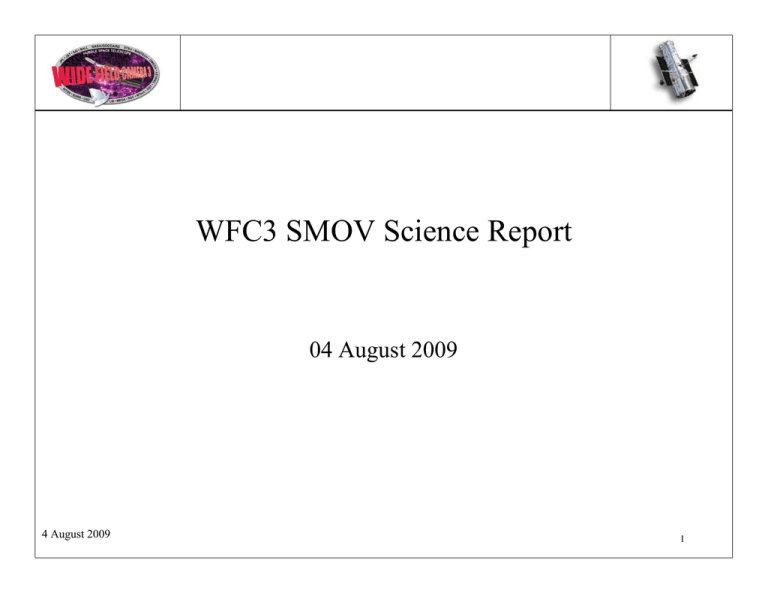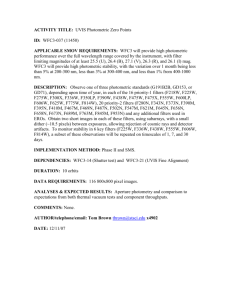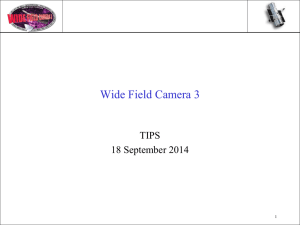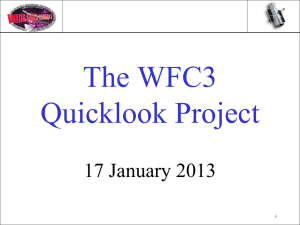WFC3 SMOV Science Report 04 August 2009 4 August 2009 1
advertisement

WFC3 SMOV Science Report 04 August 2009 4 August 2009 1 WFC3 Science Report For 04 Aug 2009 1) 11552, Characterization of the WFC3 IR Grisms, Visit 01 preliminary results 2) 11447, WFC3 IR Background 3) 11426, WFC3 UVIS Contamination Monitor 4 August 2009 2 11552, Characterization of the WFC3 IR Grisms • Activity - Visit 01 (of 4). • Objective – Measure image displacement, spectral trace and dispersion, and throughput of the IR G102 and G141 grisms. • Status – Visit 01: Successfully obtained G102 spectra of flux standard GD-153 at 3 different IR field points (center and two corners). • Results » Quick look shows GD-153 well exposed, at expected levels, and at expected locations within the field 4 August 2009 3 11552 Image Embargoed figure - Do not distribute 0th order 1st order 2nd order other stars Flux standard GD-153 with the WFC3/IR G102 grism 4 August 2009 4 11447, WFC3 IR Background • Activity - Visit 34 (of 22). Proposal measures readnoise, dark current and diffuse background in IR channel. • Objective – Measure diffuse background light in the IR channel through observations of low stellar density fields • Status – 3 external orbits in Visit 34, aimed at the HST orbit pole obtained on 2009/july/19 analysis ongoing, • Preliminary Results » definite illumination pattern in the frame, near bright earth limb, appears in each of five exposures during Visit 34, shape is the same but brightness changes. » Up to factor of 2 difference in brightness between “dark” and “bright” sides of image. » Background light, as measured for each W&M filter from external images of a single field of medium zodiacal light level, are compared to those anticipated from known sources (e.g. Zodiacal light) and WFC3 throughput (cf. Table 7.12 of Instrument Handbook), but this is still ongoing analysis. 4 August 2009 5 11447 IR Background @Orbit Pole Aug 3, 2009 Stray light at left side of the IR sensor (quads 1 and 2) evident in ~75 deg of 360 deg of HST orbital phase, of Visit 34 of Program 11447 of the orbit pole. Sky is as much as twice as bright in columns 5-204 as in columns 512-711. Morphology of stray light is the same in each of the five exposures in which it appears; only its brightness changes. From individual samples up the ramp, we estimate that the blurred edge of the stray light (near column 200) is not due to image motion evident in stars.* *Due to gyro guiding snafu, the coordinates of _raw.fits ((298,-21) = incorrect) differ from _jif.fits 4((162,+61) August 2009 = correct, they match the star field) ! 6 11447 IR Background @Orbit Pole Columns 5:204 512:711 Earth Shine Earth Shine Aug 3, 2009 4 August 2009 7 11447: Total ETC Background 4 August 2009 8 11426 – UVIS Contamination Monitor • • Activity - monitor UV photometric throughput over time & wavelength Objectives - Measure relative throughput as a function of time and wavelength. Assess internals for any changes in readnoise, dark current, or flatfield. – Observe one white dwarf standard star (grw+70) with 512x512 subarrays one per chip (C512A, C512C) once per week during SMOV – Two exposures obtained in all UV filters plus F606W, F814W and also 2 biases, 2 darks, 3 tungsten flats (f336w, f438w, f606w) • • Status - Six visits completed, over period of 33 days, including before and after the second anneal in July. Results: No significant changes in relative throughput as function of time; Readnoise of science pixels stable, amp B shows lowest scatter (stdev 0.01) compared to other amps (0.02-0.03). Dark current is stable Lamp output decreased by ~1% over the ~35days. 4 August 2009 9 11426 Co-adding bluest filters UVIS1, C512A UVIS2, C512C anneal Relative flux Relative flux anneal Co-added f218w, f225w, f275w, f280n 4 August 2009 10 Readnoise - Readnoise in e-/s/pix in the different quadrants - Based on science pixels only - Measured from bias pairs, assuming gain=1.5e-/DN - No trend with time - Statistics as a set: Amp A B C D mean 2.90 2.98 2.89 3.00 stdev 0.03 0.01 0.02 0.02 A C B D median 2.91 2.98 2.89 3.01 -Outliers under investigation 4 August 2009 11 Dark current over time Discussed in more detail elsewhere but included here for completeness. Median dark levels, in e-/s/pix, for chip 2 as function of MJD; anneals marked with dashed lines. Three highest darks still under investigation; so far, no correlation with time since pinning (bowtie) exposure, window temperature, bright earth, time since SAA passage, or hot pixels. 4 August 2009 12 Contam.monitor intflats - levels 1.02 F336W visit2/1 visit6/1 0.98 F438W visit2/1 visit6/1 F606W visit2/1 visit6/1 4 August 2009 - Average line plots through chip1 in Visit2/Visit1 ratio and Visit 6/Visit 1 ratio, with 33 days between Visit 6 & 1 - F336W flats are noisier: tungsten lamp is relatively red so that despite long exptime (2000sec) they have only ~20% flux level of F438W, F606W - Ratios are flat except for expected filter features - Lamp seems to be dimming slightly: ~1% decrease in flux seen in all three filters. Similar trend seen in bowtie monitor. F336W mean stdev 1.003 0.015 1.002 0.017 0.996 0.017 0.996 0.015 0.995 0.017 0.995 0.015 0.990 0.017 0.990 0.015 0.988 0.017 0.988 0.015 IMAGE RATIO STATISTICS, CHIP 1 F438W F606W median mean stdev median mean stdev median 1.002 1.003 0.007 1.003 1.007 0.007 1.007 1.002 1.003 0.007 1.002 1.007 0.007 1.007 0.996 1.001 0.007 1.001 0.999 0.007 0.999 0.996 1.000 0.007 1.000 0.999 0.007 0.999 0.994 1.000 0.007 1.000 1.000 0.007 1.000 0.994 1.000 0.007 1.000 1.000 0.007 1.000 0.989 0.990 0.007 0.990 0.991 0.007 0.991 0.989 0.991 0.007 0.991 0.991 0.007 0.991 0.988 0.989 0.007 0.989 0.991 0.007 0.990 0.988 0.989 0.007 0.989 0.991 0.007 0.991 Filter features appearing in ratio due to first intflat of the set being shifted relative to others 13


